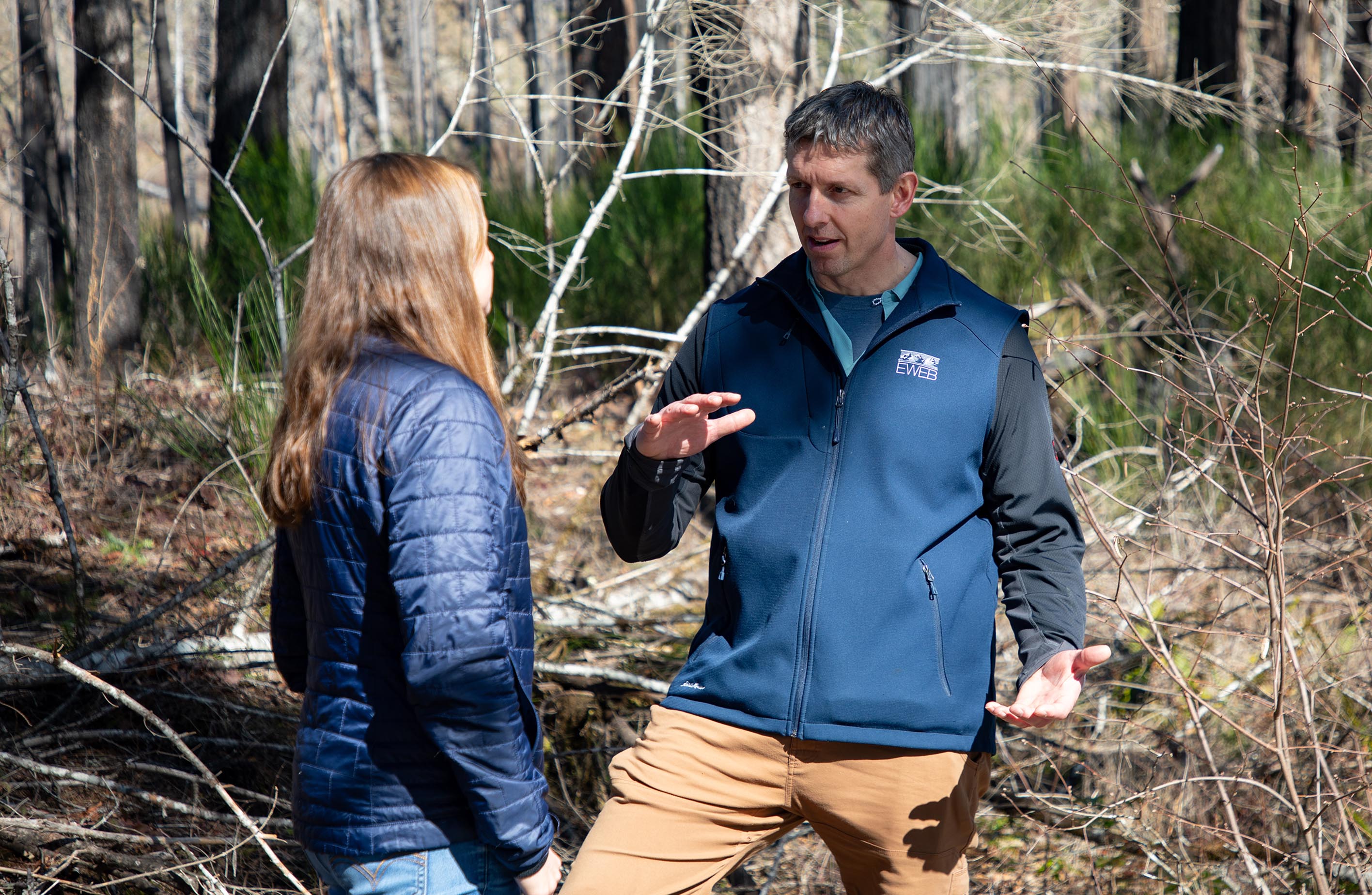Related News
Related News
-
Sustainability Snapshot - Celebrating Energy Efficiency Projects in the Community
Sustainability Snapshops highlight impactful projects completed by EWEB's Customer Solutions department, as a way to celebrate the meaningful work happening behind the scenes.
Find Out More -
McKenzie Valley electric service territory realignment study reaches key milestone
EWEB Commissioners approved a resolution authorizing the General Manager to negotiate and execute agreements with Lane Electric Cooperative regarding a potential realignment of electric service territory in the McKenzie Valley at the Board’s December meeting.
Find Out More -
EWEB Sets 2026 Budget and Rates, Advances Evaluation of McKenzie Valley Service Territory Realignment
Taken together, the 2026 budget and rate adjustments and the territory-realignment evaluation reflect EWEB’s dedication to responsible financial stewardship, modern, resilient utility infrastructure, and thoughtful planning for the future.
Find Out More -
Women in STEM: Meet the Hydro Project Engineer Building Habitat for Salmon
EWEB Engineer Associate Val Chang found her way to the McKenzie River from Los Angeles, inspired by heritage trips to the waters of Taiwan and key mentors along the way.
Find Out More -
Public Power Week Poster Contest Winners 2025
The results are in! View the winning posters from EWEB's 2025 Public Power Week Poster Contest.
Find Out More -
EWEB Hometown Heroes compete internationally
Out of 290 teams from 14 different countries, EWEB's Lineman Rodeo team places in the top third of competitors.
Find Out More -
EWEB's Halloween Truck-or-Treat is a huge success
Community members are accustomed to spotting EWEB trucks around Eugene streets and neighborhoods. But last week, those familiar vehicles looked a little different. At EWEB's second annual Truck-or-Treat Customer and Crew Appreciation Event, our fleet transformed into a festive Halloween spectacle.
Find Out More -
Let's Talk Turkey. Is your family ready for winter?
We're heading into the holidays, but that also means snow, ice, and not-so-nice weather might be in the forecast. Here are some tips to prepare in advance.
Find Out More -
Vote for your favorite Public Power Week Posters
The top five submittals will receive awards. Help us pick the winners.
Find Out More -
EWEB Hosts Annual Spill Drill to Protect McKenzie River
EWEB led emergency responders in its annual “spill drill” on the McKenzie River on Wednesday, Oct. 15, at the Trail Bridge Campground.
Find Out More -
A day in the life: Monitoring water quality throughout the McKenzie Watershed
Follow Senior Environmental Specialist David Donahue as he collects water quality samples from throughout the watershed as part of EWEB's early warning system for threats to Eugene's drinking water.
Find Out More -
EWEB Partners with Eugene School District 4J to Celebrate New Kennedy Middle School Emergency Water Station Site
Hundreds of attendees practiced filling up water containers at Saturday's demonstration event.
Find Out More -
Electric Projects underway in North & South Eugene
Underground lines and disaster-resilient power poles are part of EWEB’s infrastructure upgrade near Eugene’s largest natural resource area.
Find Out More -
EWEB general manager to retire in 2026
EWEB launches nationwide search for next leader to continue the progress of the last decade and ensure a smooth transition.
Find Out More -
Quartz Creek: Setting the Stage for Floodplain Restoration
The project resets the floodplain along 1.8 miles of a formerly channelized creek to improve water quality, fish habitat and natural disaster resiliency.
Find Out More - Show More
NASA partners with EWEB to assess wildfire impacts to drinking water
July 02, 2025 • Adam Spencer, EWEB Communications

How strong is Eugene’s reputation for protecting our rivers?
It’s so good, it can be seen from space!
In another example of EWEB’s innovative approach to protecting the McKenzie River from evolving threats, EWEB is partnering with NASA’s Earth Information Center (EIC) and fire ecology researchers throughout the region to study the effects of wildfires on our watersheds.
In a recent video, NASA featured EWEB’s role as a key collaborator in its work to develop remote sensing capabilities and new modelling tools to advise watershed managers on wildfire threats and impacts.
“Our forests and more than just trees. They're part of a living water filtration system that provides millions of people with clean drinking water,” Julie Padowski – Washington State University Co-Director for the Center for Environmental Research, Education and Outreach, says in the video. “A severe fire burns vegetation that normally holds soil in place. And then when it rains, instead of soil slowly absorbing and filtering to the forest, it rushes across the burned ground. This increases the risk of flooding, mudslides, and debris flows into water supplies downstream.”
EWEB’s Drinking Water Source Protection (DWSP) Team has been facing the reality of these impacts since the 2020 Holiday Farm Fire.
“We haven't really had those kind of larger, catastrophic wildfires in this area before the Holiday Farm Fire that came through burned almost 200,000 acres, and that was a concern for our drinking water as well,” says EWEB Water Resources Manager Susan Fricke. “As a public utility, the money we operate with is coming from people that are paying their water and electric bills. So we love working with NASA's supported research because we can find the most efficient way to use those funds to protect source water, to treat our water, and to do all of our operations.”
In the immediate aftermath of the Holiday Farm Fire, EWEB’s Hayden Bridge Drinking Water Treatment Plant was able to effectively manage the challenges caused by the fire. And the DWSP Team has been working with landowners, local and federal agencies, and management partners to protect water quality by restoring and fortifying the McKenzie River in the areas that burned.
Nevertheless, bringing in more information and collaborators like NASA to safeguard the source of drinking water for 200,000 people in the Eugene area provides clear advantages.
“To maximize the use of new modeling tools to track potential rainfall, predict debris flows, and allocate limited resources appropriately can be extremely beneficial to natural resource managers addressing post wildfire impacts,” says EWEB Environmental Specialist David Donahue. “It really takes a community and having their expertise and knowledge – and partnership with NASA – helps us folks as boots on the ground to make better decisions on how we manage these forested areas.”

